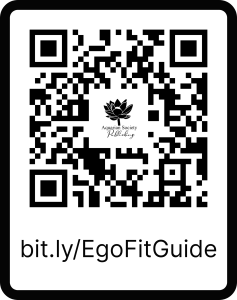This is a guided practice for combating fatigue and boosting energy. Suitable for a 40-day Kriya practice. It emphasizes the importance of the parasympathetic nervous system, which is the “rest and digest” system, over the sympathetic nervous system. The practice involves chanting “Ong Namo, Guru, Dev Namo” to activate the vagus nerve and balance higher centers. It includes breathing exercises, such as pushing the belly out on the inhale and in on the exhale, and the “EgoFit” exercise, which involves specific arm positions to activate the nervous system and lymph nodes. The practice concludes with a “Sat Nam” mantra to honor the breath and the teachers.
Listen to the #EgoFit guide:
Introduction to the Practice
- Siri Geet introduces the audio guide for a 15-minute combat fatigue practice, emphasizing the importance of the audio over the video.
- Siri Geet mentions the guide is for a video, indicating it is more of a companion to the video content.
- Siri Geet welcomes participants to the practice, focusing on combating fatigue and retrieving energy, suitable for a 40-day Kriya practice.
- The practice begins with tuning in using the mantra “Ong Namo, Guru, Dev Namo,” which brings concentration to the navel point and balances higher centers.
Understanding the Parasympathetic Nervous System
- Siri Geet explains the significance of the parasympathetic nervous system, which is the “rest and digest” system, and its role in decision-making and relationships.
- The practice aims to activate the parasympathetic nervous system, increasing patience and reducing anger.
- The mantra “Ong Namo, Guru, Dev Namo” is highlighted for its ability to bring awareness to the vagus nerve and activate the parasympathetic nervous system.
- Siri Geet encourages participants to chant the mantra or listen silently, focusing on the energy brought by pressing the thumb knuckle to the sternum.
Comfortable Seated Position and Breathing Techniques
- Siri Geet guides participants into a comfortable seated position, emphasizing the importance of the belly in activating the vagus nerve.
- The breathing technique involves pushing the belly out on the inhale and in on the exhale, activating the vagus nerve and parasympathetic nervous system.
- Participants are instructed to inhale and exhale while focusing on the breath, with the belly as the anchor.
- The practice includes stretching the sides by reaching one arm up and the other down, alternating sides to breathe into the waist.
#EgoFit Exercise
- Siri Geet introduces the “EgoFit” exercise, which involves placing the arms at a 90-degree angle and then a 60-degree angle to activate the nervous system and lymph nodes.
- The exercise is designed to build pressure and friction, conditioning the nervous system and improving overall wellness.
- Participants are encouraged to breathe into the exercise and not judge themselves, understanding that the stress and friction are beneficial.
- The exercise includes folding the fingers into the pads of the palms with the thumb extended, activating the wrist and nervous system.
Breath of Fire and Tongue Stick
- Siri Geet explains the Breath of Fire (BofF) technique, which involves pushing the belly out on the inhale and in on the exhale, activating the root of the parasympathetic nervous system.
- The “Tongue Stick” exercise involves sticking the tongue out as far as possible, activating the heart-brain connection and the sublingual channel.
- Participants are instructed to keep their arms stretched out and breathe deeply, focusing on the activation of the parasympathetic nervous system.
- The exercise is described as a full-body workout, building energy and activating the midsection and entire body.
Final Poses and Relaxation
- Siri Geet guides participants into the “Ego Fit” posture, with the arms at a 60-degree angle and the thumbs and fingers in specific positions.
- The practice includes relaxing the neck and shoulders, focusing on the breath and the activation of the core and parasympathetic nervous system.
- Participants are encouraged to direct their emotions into their body and use the “Sat Nam” mantra to anchor their attention.
- The practice concludes with participants bringing their arms down, placing their palms on their knees or thighs, and relaxing their shoulders.
Closing and Three-Part Breath
- Siri Geet instructs participants to relax and let the energy disperse throughout their body, using the “Ego Fit” practice to energize their ego.
- Participants are encouraged to use the energized ego in their daily life and decisions, aiming for a light and airy feeling.
- The practice includes moving into the cobra pose or an extended spinal flex, strengthening the low back and spine.
- Siri Geet guides participants into a child’s pose or an extended child’s pose, offering adjustments for those in a chair.
Three-Part Breath and Final Exhale
- Siri Geet introduces the three-part breath, which involves segmenting the inhale through the stomach, chest, and upper chest, and the exhale in the opposite order.
- Participants are instructed to touch their right hand to their belly button on the inhale and their left hand to their chest on the exhale.
- The three-part breath is described as relaxing to the nervous system and can be done anywhere.
- Siri Geet encourages participants to keep surrendering to their breath of choice, with a final big exhale and inhale to nourish the body.
Closing with Sat Nam
- Siri Geet guides participants into a seated position, bringing their hands into prayer pose to close the practice.
- The practice concludes with a long “Sat Nam” and a short “Sat Nam,” honoring the breath and the teachers who have taught them.
- The “Sat Nam” mantra is explained as a way to thank the breath and unite with it, honoring the teachers and bringing authenticity to the practice.
- Siri Geet thanks participants for practicing and concludes the session, indicating the end of the guide.




































